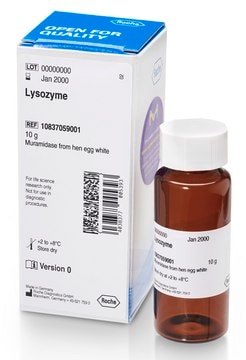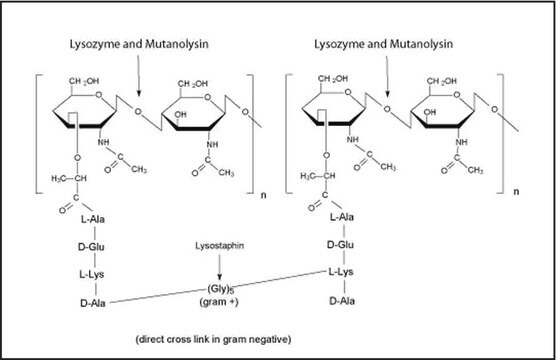おすすめの製品
詳細
Purified Lysozyme DNA free SAE0152 undergoes strict quality control testing to ensure the absence of detectable levels of contaminating DNA using 35 cycles PCR amplification of 16S and 18S rDNA using universal primer sets.
Lysozyme is a single chain polypeptide of 129 amino acids cross-linked with four disulfide bridges.1 It hydrolyzes b(1à 4) linkages between N-acetylmuraminic acid and N-acetyl-D-glucosamine residues in peptidoglycan and between N-acetyl-D-glucosamine residues in chitodextrin.2,3,4 The enzyme is often used for lysing bacterial cells by hydrolyzing the peptidoglycan present in the cell walls. Gram-positive cells are quite susceptible to this hydrolysis as their cell walls have a high proportion of peptidoglycan. Gram-negative bacteria are less susceptible due to the presence of an outer membrane and a lower proportion of peptidoglycan.
The enzyme is active over a broad pH range (6.0-9.0).
Lysozyme activity: ≥40,000 units/mg protein.
For isolation of nucleic acids, lysozyme has been used in the lysis peptidoglycan layer of bacterial cell walls.
The study of microbial communities has been revolutionized in recent years by the widespread adoption of culture independent analytical techniques such as 16S rRNA gene sequencing and metagenomics. Since DNA contamination during sample preparation is a major problem of these sequence-based approaches, DNA extraction reagents free of DNA contaminates are essential. This purified lysozyme preparation (SAE0152) is purified from chicken egg white, crystallized three times, dialyzed, and supplied as a lyophilized powder. Protein content by UV absorbance is ≥ 90% with the remainder (∼10%) being buffer salts such as sodium acetate and sodium chloride, and undergoes strict quality control testing to ensure the absence of detectable levels of contaminating DNA using 35 cycles PCR amplification of 16S and 18S rDNA using universal primer sets.
Lysozyme is a single chain polypeptide of 129 amino acids cross-linked with four disulfide bridges.1 It hydrolyzes b(1à 4) linkages between N-acetylmuraminic acid and N-acetyl-D-glucosamine residues in peptidoglycan and between N-acetyl-D-glucosamine residues in chitodextrin.2,3,4 The enzyme is often used for lysing bacterial cells by hydrolyzing the peptidoglycan present in the cell walls. Gram-positive cells are quite susceptible to this hydrolysis as their cell walls have a high proportion of peptidoglycan. Gram-negative bacteria are less susceptible due to the presence of an outer membrane and a lower proportion of peptidoglycan.
The enzyme is active over a broad pH range (6.0-9.0).
Lysozyme activity: ≥40,000 units/mg protein.
For isolation of nucleic acids, lysozyme has been used in the lysis peptidoglycan layer of bacterial cell walls.
The study of microbial communities has been revolutionized in recent years by the widespread adoption of culture independent analytical techniques such as 16S rRNA gene sequencing and metagenomics. Since DNA contamination during sample preparation is a major problem of these sequence-based approaches, DNA extraction reagents free of DNA contaminates are essential. This purified lysozyme preparation (SAE0152) is purified from chicken egg white, crystallized three times, dialyzed, and supplied as a lyophilized powder. Protein content by UV absorbance is ≥ 90% with the remainder (∼10%) being buffer salts such as sodium acetate and sodium chloride, and undergoes strict quality control testing to ensure the absence of detectable levels of contaminating DNA using 35 cycles PCR amplification of 16S and 18S rDNA using universal primer sets.
アプリケーション
- Lysozyme is used for the extraction of genomic DNA from bacterial cells.
- Lysozyme is used as an external standard for MALDI-TOF (matrix assisted laser desorption ionization-time of flight) mass analysis.
- Lysonzyme is used to prepare spheroplasts.
この酵素は、細菌の細胞壁を破壊します。スフェロプラストの調製に使用されます。
生物化学的/生理学的作用
リゾチ-ムは、N-アセチルムラミン酸とN-アセチル-D-グルコサミン残基との間の、ならびにキトデキストリン内のN-アセチル-D-グルコサミン残基同士の間のβ(1→4)結合を加水分解します。 グラム陽性菌は細胞壁におけるペプチドグリカンの比率が高いため、この加水分解反応に対して高い感受性を示します。 グラム陰性菌は外膜を持ち、ペプチドグリカンの比率が低いため、この加水分解反応に対する感受性は高くありません。 しかし、これらの細胞も、菌体の外膜に存在する金属イオンをキレ-トするEDTAの存在下であれば加水分解が可能です。
リゾチ-ムは、広いpH範囲(6.0~9.0)で活性を示します。 pH 6.2(0.02 ~ 0.100 M)では、pH 9.2(0.01 ~ 0.06 M)の場合よりも、極大活性がより広いイオン強度範囲で認められます。
リゾチ-ムは、広いpH範囲(6.0~9.0)で活性を示します。 pH 6.2(0.02 ~ 0.100 M)では、pH 9.2(0.01 ~ 0.06 M)の場合よりも、極大活性がより広いイオン強度範囲で認められます。
特徴および利点
Purified Lysozyme free SAE0152 undergoes strict quality control testing to ensure it will be Free of DNA contaminants, suitable for Microbiome research.
The study of microbial communities has been revolutionized in recent years by the widespread adoption of culture independent analytical techniques such as 16S rRNA gene sequencing and metagenomics. Since DNA contamination during sample preparation is a major problem of these sequence-based approaches, DNA extraction reagents free of DNA contaminates are essential.
The study of microbial communities has been revolutionized in recent years by the widespread adoption of culture independent analytical techniques such as 16S rRNA gene sequencing and metagenomics. Since DNA contamination during sample preparation is a major problem of these sequence-based approaches, DNA extraction reagents free of DNA contaminates are essential.
単位の定義
One unit will lyse 0.6 μg of Micrococcus lysodeikticus per minute by turbidimetric detection at 600 nm when suspended in buffer at pH 6.2 at 25 °C.
シグナルワード
Danger
危険有害性情報
危険有害性の分類
Resp. Sens. 1
保管分類コード
11 - Combustible Solids
WGK
WGK 3
引火点(°F)
Not applicable
引火点(℃)
Not applicable
適用法令
試験研究用途を考慮した関連法令を主に挙げております。化学物質以外については、一部の情報のみ提供しています。 製品を安全かつ合法的に使用することは、使用者の義務です。最新情報により修正される場合があります。WEBの反映には時間を要することがあるため、適宜SDSをご参照ください。
Jan Code
SAE0152-1G:
SAE0152-BULK:
SAE0152-1G-PW:
SAE0152-VAR:
試験成績書(COA)
製品のロット番号・バッチ番号を入力して、試験成績書(COA) を検索できます。ロット番号・バッチ番号は、製品ラベルに「Lot」または「Batch」に続いて記載されています。
ライフサイエンス、有機合成、材料科学、クロマトグラフィー、分析など、あらゆる分野の研究に経験のあるメンバーがおります。.
製品に関するお問い合わせはこちら(テクニカルサービス)






